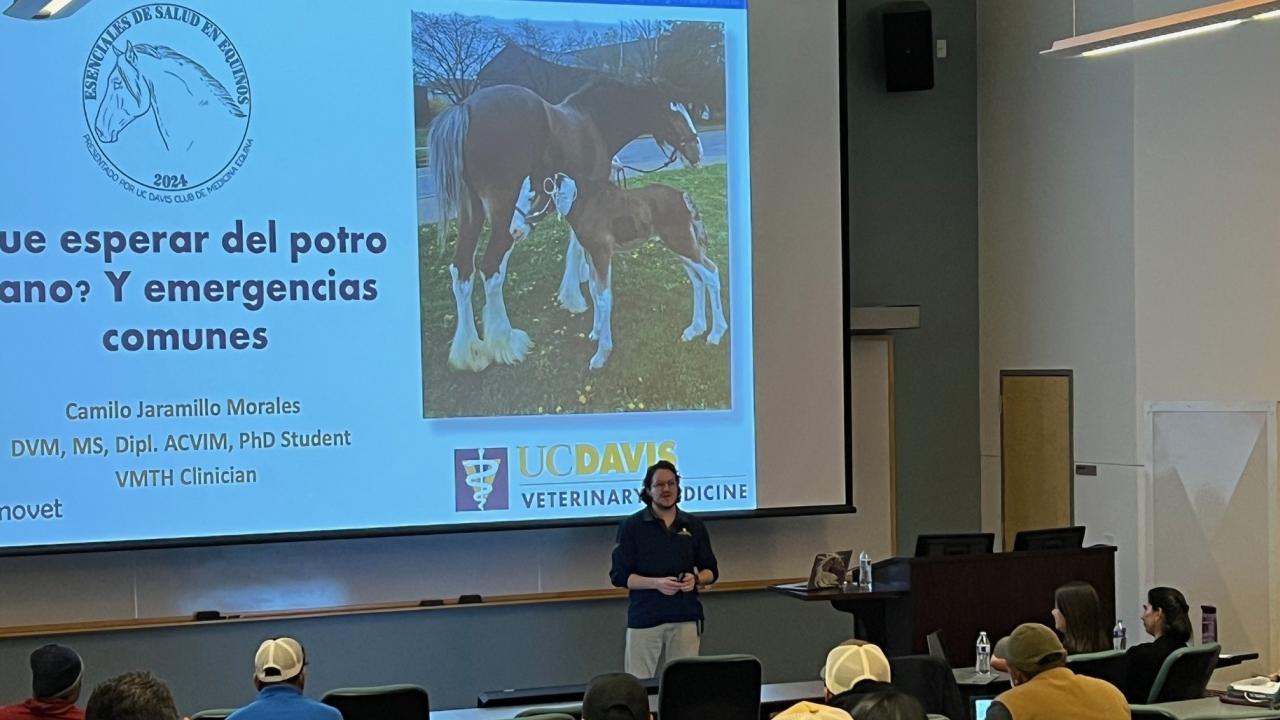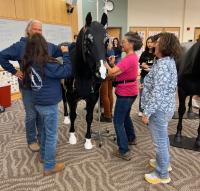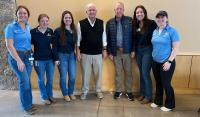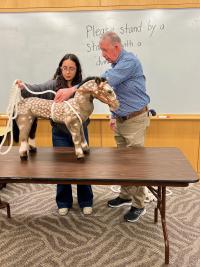
Equine Essentials Symposium Offers Bilingual Learning

The UC Davis School of Veterinary Medicine’s Equine Essentials Symposium welcomed the return of a pre-pandemic public equine education event, this time offering tracks in both English and Spanish. The event was organized by members of the Equine Medicine Club, a group of full-time UC Davis veterinary students that represent the local student chapter of the American Association of Equine Practitioners.
“It started with six passionate equine veterinary students,” said Nicole Gonzales, co-president of the Equine Medicine Club. “We share a passion to provide educational opportunities to members of our local equine community. When we learned of the history of the Equine Medicine Club Symposium, we began figuring out how to put on an event of this scale. While juggling veterinary school and other responsibilities, we were able to make our dream a reality.”
Clinicians in the UC Davis veterinary hospital’s Large Animal Clinic recognized the need for educational opportunities for Spanish-speaking equine owners, and this was the perfect event to make it happen.
“We had a great turnout in the Spanish sessions for our first year, with wonderful support from the Equine Medicine Club and Latin X Club, as well as our terrific multilingual speakers,” said Dr. Emily Berryhill, assistant professor of medicine and epidemiology. “I am so excited to watch our outreach grow in the future so we can provide owners with tools to help make informed decisions for their animals.”
The nearly 250 registrants, some of whom came from as far away as Los Angeles, chose between a variety of presentations from UC Davis clinicians, with topics including how to handle a down horse, common emergencies in foals, and how to recognize colic, among many others.
“It was so hard to choose,” said one participant. “I wish I could have gone to all of the presentations.”

Dr. Bill Rood’s keynote address was standing room only. A co-founder of the esteemed Rood and Riddle Equine Hospital, established in Lexington, Kentucky, Rood shared the story of his personal journey in equine veterinary medicine. It included not only a veterinary degree from UC Davis, but also a law degree from the University of Kentucky. He presented an historical timeline of the clinic’s development from a backyard garage to a now 140,000 square foot facility with numerous buildings and more than 100 veterinarians on site, as well as satellite clinics in New York and Florida.
Rood offered insights into the business of equine veterinary medicine, giving horse owners in the audience an idea of the background logistics and costs inherent in running equine clinics. He emphasized good communication skills, business acumen, and the ability to hire and retain the best people, important lessons for the students in attendance.

After lunch and a drawing for raffle prize winners, participants spent the afternoon cycling through three demonstration tracks. Dr. John Madigan spoke about the Madigan Squeeze Technique for foals that exhibit neurological abnormalities (“dummy foals”) and helped attendees learn rope placement for the technique on stuffed horse and dog models. Drs. Julie Dechant and Lais Costa demonstrated how to perform intramuscular injections and participants practiced what they learned on the life-sized models in the teaching laboratory. Down the hall, Dr. Lucy Woodward outlined how veterinarians perform lameness evaluations, with an emphasis on procedures used to identify specific issues.
Spirits were high among the attendees throughout the day, with more than one participant commenting that it was wonderful to have this event back again and to be able to connect with the equine community.
“The community’s enthusiastic response to this symposium surprised us all, as our attendance reached beyond capacity,” said Gonzales. “This proved to us that educational opportunities in equine medicine are needed within our community, and we plan to continue to answer this call.”
Thank you to the sponsors that helped make the event possible, including the Northern California Association of Equine Practitioners, Boehringer Ingelheim, Zoetis Animal Health, Platinum Performance, Aurora Pharmaceutical, and Elk Grove Milling.
# # #
